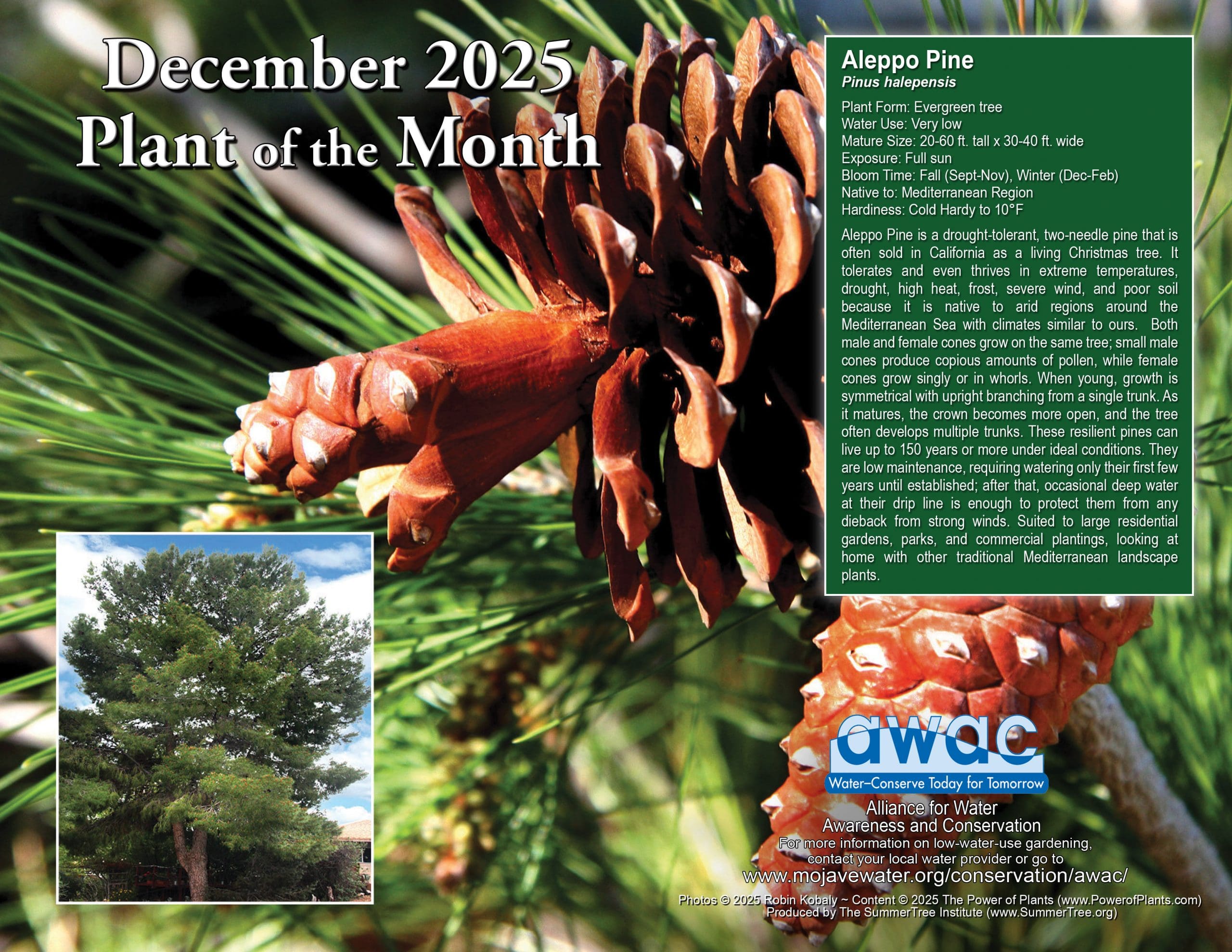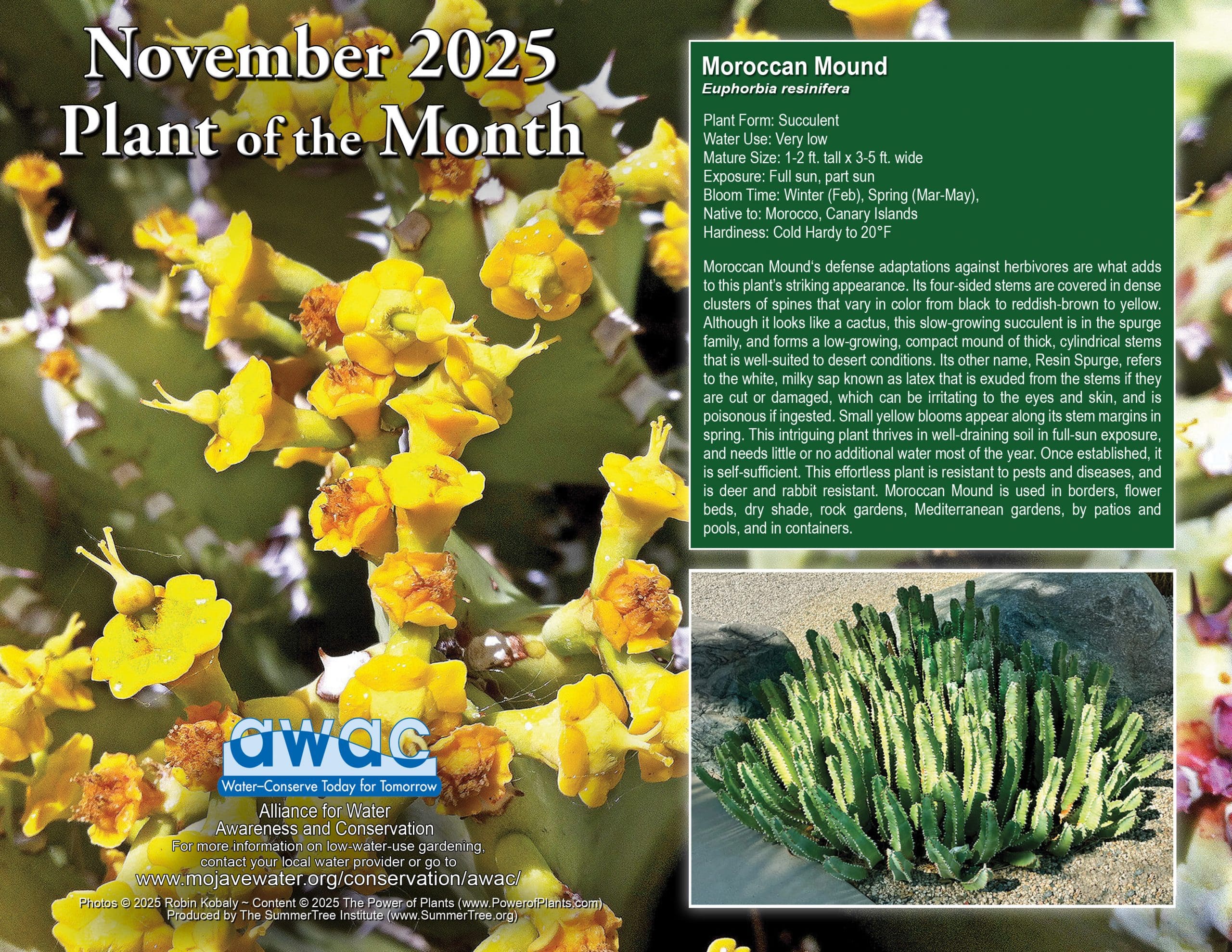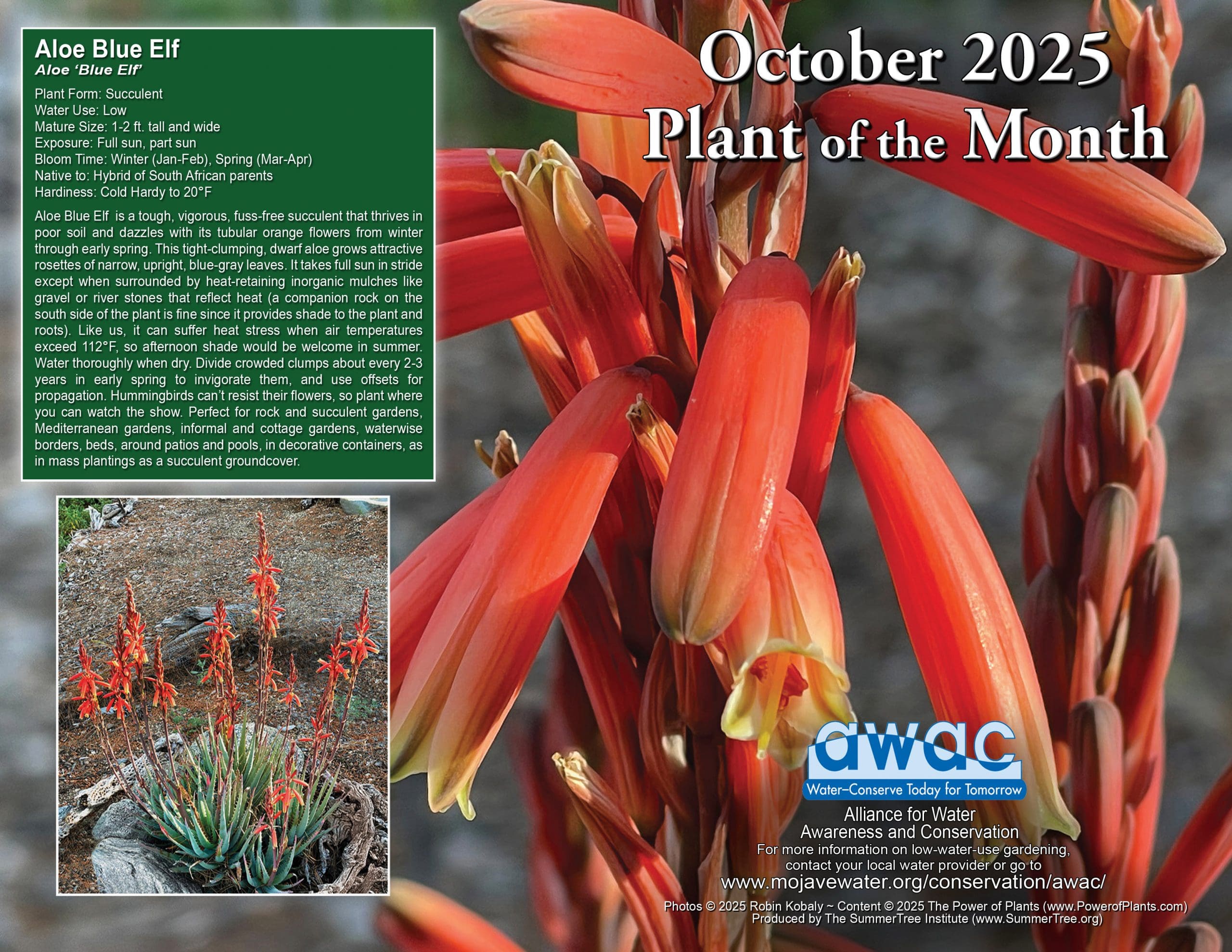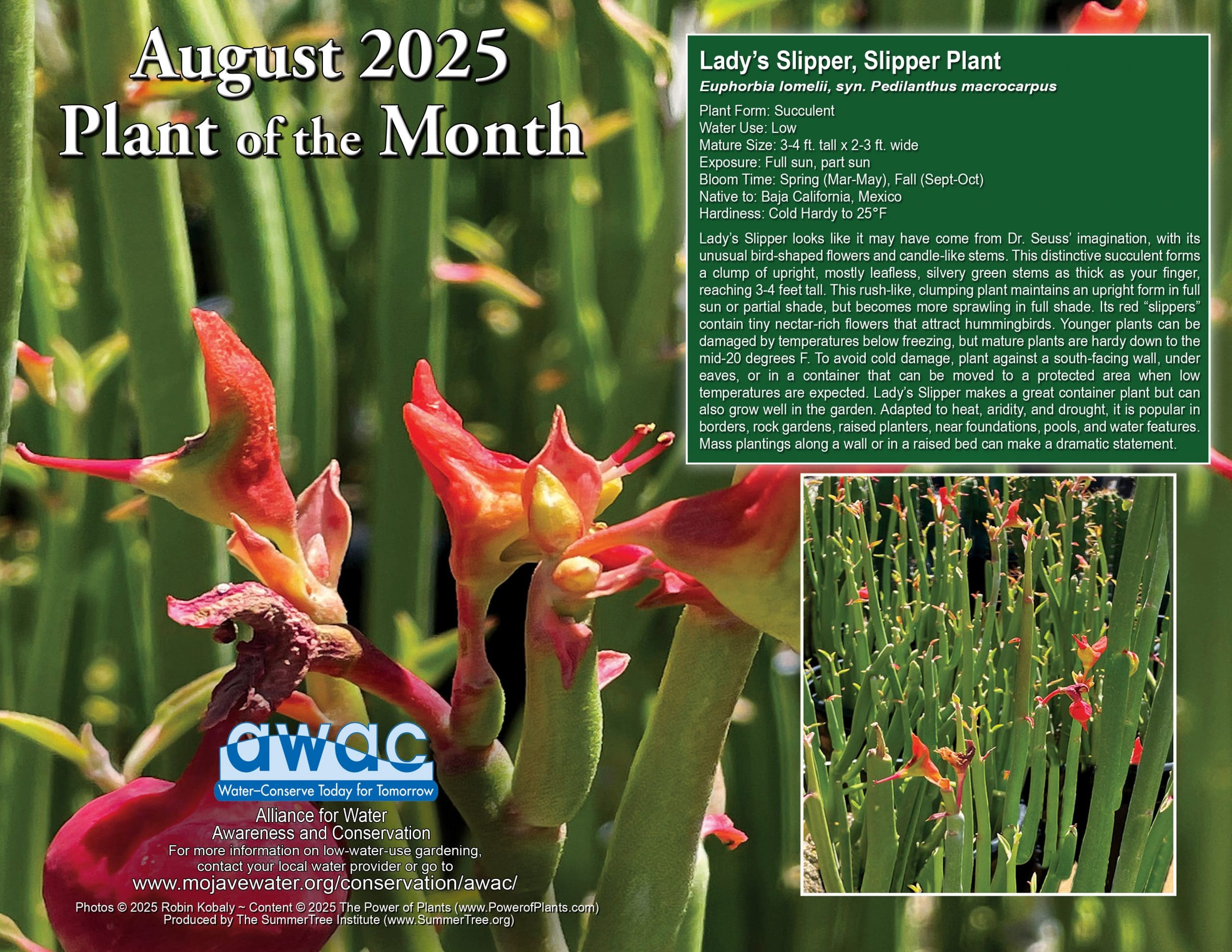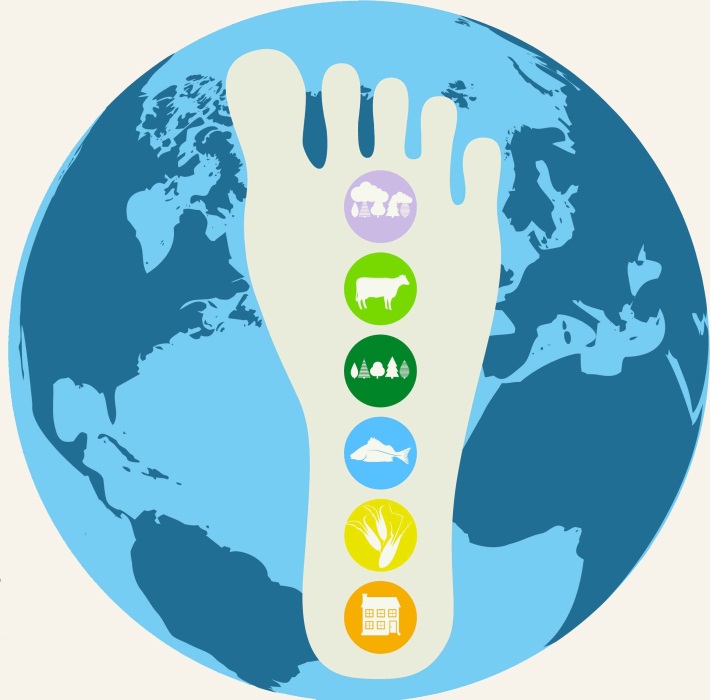Plant Form: Succulent Water Use: Very low Mature Size: 1-2 ft. tall x 3-5 ft.…
News and Information
Conservation Resources
On March 24, 2023, the Governor signed Executive Order N-5-23 proclaiming the end of Stage 2 water restrictions. Therefore, on May 23, 2023, the Board of Supervisors approved to rescind Stage 2 – Drought Alert and adopt a new resolution declaring Stage 1 – Drought Watch for the CSAs in accordance with the Water Conservation Program Ordinance No. SD 15-04 and the Governor’s Executive Order N-5-23.
We ask that you continue to adhere to Executive Order B-37-16, “Making Conservation a California Way of Life” restrictions that prohibit wasteful practices such as:
- Hosing off sidewalks, driveways and other hardscapes;
- Washing automobiles with hoses not equipped with a shut-off nozzle;
- Using non-recirculated water in a fountain or other decorative water feature;
- Watering lawns in a manner that causes runoff, or within 48 hours after measurable precipitation; and
- Irrigating ornamental turf on public street medians
Please note that outdoor irrigation is limited to 4-days per week and the summer/winter watering times will remain in effect.
Helpful Water Conservation Links
- Save Our Water – Water Conservation. It’s For Life.
- CA Drought Resources – CA Institute
for Water Resources - CA Drought – Pacific Institute
- UCCE Master Gardener
- UCCE San Bernardino County Drought Resources
- Save Water When Traveling
Indoor Water Use
Indoor Water accounts for about 40% of all water used in a residential home and can often be one of the easiest places to curb your usage, saving you money on your water bill. Simply turning the water off while brushing your teeth, making sure there is a full load when washing your clothes or dishes, or re-using a water glass can save thousands of gallons each year! Finding and fixing leaks early can also cut water use by as much as 13.7%! Explore the resources below for ways you can save.

Tips for Checking for Leaks in Your Home
Using Your Water Meter to Find a Leak
One of the quickest places to determine if you have a leak occurring in your home is at your water meter. After turning off all of the water in your home, if the water meter is still running, you will know there is a leak occurring.
- Before beginning, be sure to turn off all of the water both inside and outside of your home.
- Write down the full read on your water meter.
- Wait at least 15 minutes and compare your reads to determine the amount of water (if any) that has passed through the water meter.
- If you have turned all water sources off (ice maker, air conditioner, etc.) and the meter read is greater that the initial read, then you may have a leak.
Checking a Toilet for Leaks
Did you know that replacing an older, inefficient toilet with a WaterSense labeled model can save 13,000 gallons per year and nearly $2,400 in water use and water waste over the lifetime of the toilet?
Toilets are regularly the most common source of leaks in a household and can often be the easiest to fix.
- Open the toilet tank located in the back of your toilet.
- Add dye tablets or a few drops of food coloring to the toilet tank.
- Do not flush the toilet for 15 minutes.
- Return to the toilet to see if there is any color in the main toilet bowl.
- If there is color in the bowl, you probably have a leak that will require additional investigation.
Since most toilet leaks are the result of a faulty flapper valve, below are a few steps for replacing the most common flapper types:
- Open the toilet tank located in the back of your toilet.
- Add dye tablets or a few drops of food coloring to the toilet tank.
- Do not flush the toilet for 15 minutes.
- Return to the toilet to see if there is any color in the main toilet bowl.
- If there is color in the bowl, you probably have a leak that will require additional investigation.
Kids Corner
Ecological Footprint
Ever wondered what impact you have on the planet or maybe how much “nature” supports your lifestyle?
Try completing the ecological footprint quiz and find out how you’re doing and ways you can help!
Test Your Watersense
Think you know a thing or two about water? Try moving our water-efficiency hero, Flo, through pipes, answering water-efficiency questions while avoiding water-wasting monsters.
The Cycle of Water
The earth is composed of about 70% water, but only 1% of that water is in a form usable by humans and all other forms are stuck in places like the ocean, ice caps, deep in the ground, or even within you and me. So if we can only use a small amount of water on the Earth, then how have we not run out of water by now? The answer lies in the Water Cycle (or Hydrologic Cycle)!
The Water Cycle seen above shows the Earth’s natural movement of water through its environment by recycling and renewing water sources over billions of years. So what does this mean…? It means there is no new water created on Earth and that glass of water you had this morning was likely one that a dinosaur also drank long ago.
There are four essential stages of the Water Cycle that everyone should know:
| Evaporation and Transpiration | Water starts in our oceans, rivers and lakes. It is there that the sun shines down on the surface, heating the water up so it turns from liquid to vapor (Evaporation). Green plants also release water vapor into the air like you release water vapor when you breathe, in a process called Transpiration. Rising air current and pressures then carry water vapor high into the atmosphere, often separating from any heavier chemicals or pollutants at this point. |
| Condensation | High in the atmosphere cooler temperatures cause the water vapor to turn back into liquid (Condensation). The continual movement of air carries the water until it becomes heavy and forms rain-carrying clouds. |
| Precipitation | As the clouds grow heavier, they will release the water they hold as rain, sleet, hail, or snow down on the earth (Precipitation). |
| Infiltration and Run-off | As the water falls to the ground in its many forms, it will either absorb back into the soil or form pools on the surface that eventually finds its way back to our rivers, lakes, and oceans (Run-off). As for the water that enters the soil, it flows deep down in the earth’s surface, having any pollutants filtered out between the dirt and rock along the way (Infiltration). This water often makes its way into natural underground pockets known as aquifers below the surface in a process called Percolation. |
